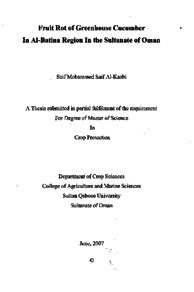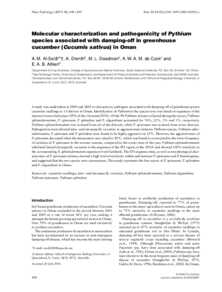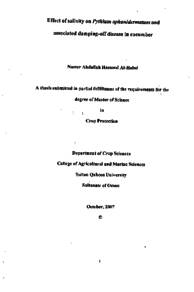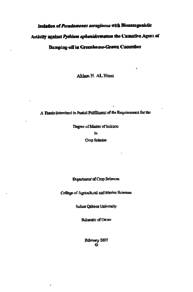Document
Fruit rot of greenhouse cucumber in Al-Batina region in the Sultanate of Oman
Publisher
Sultan Qaboos University
Gregorian
2007
Language
English
English abstract
The rapid expansion of greenhouse crop production in northern Oman in the last 5 years has been mirrored by an equally rapid increase in disease problems associated with the crops produced. Farmers are relying almost exclusively on cucumber production with three or four monoculture crops per year. Although damping-off is the principal disease constraint, flower and fruit rots cause largely unquantified, but significant losses each season. Isolations made from infected fruits indicated that the principal cause of the disease were Fusarium species. Plants were infected systemically with Fusarium being isolated from sections made at nodes throughout the stem. In addition to Fusarium, Alternaria spp. and Helminthosporium spp. were occasionally isolated from diseased fruits.
Symptoms of the disease start with gradual yellowing of the fruit from the flower end toward the petiole. As the disease progresses, infection with secondary invaders promotes fruit rot. Diseased fruits are not dropped from the plant, increasing the chance of further infection.
During the winter cropping seasons in 2003 and 2004 a commercial greenhouse was used to evaluate the effectiveness of foliar and soil-applied fungicides in reducing losses due to immature fruit rot. The first treatment consisted of weekly, foliar applications of carbendazim, the second treatment consisted of weekly, soil applications of carbendazim at and the third treatment served as a control, with no fungicide applications. In both seasons, the final percentage diseased fruits were significantly reduced both by foliar and chemigation applications of carbendazim.
Over two successive seasons, a commercial greenhouse was also used to evaluate the effectiveness of foliar applications of nutrients and fungicides, alone or in combination, in reducing the losses caused by fruit rots. The first treatment consisted of applications of carbendazim, the second treatment involved applications of foliar feed nutrients, in the third treatment, fungicide and nutrient applications were both applied, one day apart. The final treatment was a control, where plants received water sprays on the same day as treatment one. In 2003 the percentage diseased fruit was significantly reduced both by fungicide only treatment and by the combined foliar fungicide plus foliar nutrient treatments. For the foliar
feed only treatment, the level of diseased fruits was not significantly different from the control. In 2004, the highest percentage diseased fruit per plant was in the control, significantly different from the fungicide only treatment and the combined foliar fungicide plus foliar nutrient treatment. The percentage diseased fruit për plant in the nutrient only treatment was not significantly different from the control.
Member of
Resource URL
Arabic abstract
عفن الثمار في خيار البيوت المحمية بمنطقة الباطنة في سلطنة عمان
تزامن الانتشار السريع لزراعات البيوت المحمية في شمال عمان في السنوات الخمس الأخيرة مع زيادة سريعة ومتساوية المشاكل الأمراض في المحاصيل المنتجة، حيث يعتمد المزارعون على إنتاج الخيار بثلاث أو أربع عروات في السنة كمحصول حصري في البيوت المحمية. على الرغم من أن الموت المفاجىء للبادرات هو المرض الأساسي , فإن عفن الأزهار والثمار يسبب خسائر كبيرة وغير مقدرة وهامة كل موسم.
أعطى العزل من الثمار المصابة مؤشرا إلى أن السبب الرئيسي لهذا المرض هو من عائلة الفيوزاريم، حيث تصاب النباتات جهازيا بالفيوزاريم الذي يتم عزله من قطاعات في عقد الساق، بالإضافة إلى الفيوزاريم، يتم أحيانا عزل الألترناریا والهلمنثوسبوريم من الثمار المصابة.
أعراض المرض تبدأ باصفرار تدريجي للثمار من الطرف الزهري باتجاه النبات مع تقدم المرض تتم الإصابة بفطريات
ثانوية تحفز تعفن الثمار، و الثمار المصابة لا تسقط من النبات مما يزيد من احتمالات الإصابة.
تم استخدام بيت محمي تجاري في شتاء موسم 2003 و 2004 لتقييم كفاءة الرش و السقي بمبيد قطري لتقليل الإصابة بعون الثمار غير الناضجة، حيث تلخصت المعاملة الأولى في الرش أسبوعيا بمبيد الكربندازیم، أما المعاملة الثانية فقد تكونت من السقي أسبوعيا بمبيد الكریندازیم ، وأخيرا تم استخدام شاهد للتجربة كمعاملة ثالثة (بدون استخدام أي مبيد قطري). أظهرت النتائج انخفاض نسبة الثمار المصابة معنويا خلال الموسمين في كلا المعاملتين بالرش او السقي بواسطة الكربندازیم.
تم كذلك استخدام بيت محمي خلال موسمين متتابعين لتقييم كفاءة الرش بسماد ورقي ومبيد فطري علي انفراد أو مع بعض التقليل الخسائر بسبب عفن الثمار على الشكل التالي: المعاملة الأولى تتكون من رش مبيد الكربندازیم، المعاملة الثانية تتكون من رش سماد ورقي , المعاملة الثالثة تتكون من رش مبيد الكربندازیم والسماد الورقي سويا بفارق يوم واحد، أما المعاملة الأخيرة فهي الشاهد حيث تحصل فيها النباتات علي رش بالماء فقط في نفس اليوم.
انخفضت نسبة الثمار المصابة في 2003 نسبيا في المعاملة بواسطة الكريندازيم وبواسطة الكربندازیم والسماد الورقي معا ، أما بالنسبة للمعاملة بواسطة السماد الورقي فقط فان مستوى الثمار المريضة لم ينخفض معنويا بالنسبة للمشاهد.
سجلت أعلى نسبة ثمار مريضة في 2004 في الشاهد الذي اختلف معنويا عن المعاملة بالمبيد فقط وعن المعاملة المشتركة بالمبيد والسماد الورقي ، أما نسبة الثمار المصابة لكل نبات في معاملة السماد الورقي فقط كانت غير مختلفة معنويا عن الشاهد.
تزامن الانتشار السريع لزراعات البيوت المحمية في شمال عمان في السنوات الخمس الأخيرة مع زيادة سريعة ومتساوية المشاكل الأمراض في المحاصيل المنتجة، حيث يعتمد المزارعون على إنتاج الخيار بثلاث أو أربع عروات في السنة كمحصول حصري في البيوت المحمية. على الرغم من أن الموت المفاجىء للبادرات هو المرض الأساسي , فإن عفن الأزهار والثمار يسبب خسائر كبيرة وغير مقدرة وهامة كل موسم.
أعطى العزل من الثمار المصابة مؤشرا إلى أن السبب الرئيسي لهذا المرض هو من عائلة الفيوزاريم، حيث تصاب النباتات جهازيا بالفيوزاريم الذي يتم عزله من قطاعات في عقد الساق، بالإضافة إلى الفيوزاريم، يتم أحيانا عزل الألترناریا والهلمنثوسبوريم من الثمار المصابة.
أعراض المرض تبدأ باصفرار تدريجي للثمار من الطرف الزهري باتجاه النبات مع تقدم المرض تتم الإصابة بفطريات
ثانوية تحفز تعفن الثمار، و الثمار المصابة لا تسقط من النبات مما يزيد من احتمالات الإصابة.
تم استخدام بيت محمي تجاري في شتاء موسم 2003 و 2004 لتقييم كفاءة الرش و السقي بمبيد قطري لتقليل الإصابة بعون الثمار غير الناضجة، حيث تلخصت المعاملة الأولى في الرش أسبوعيا بمبيد الكربندازیم، أما المعاملة الثانية فقد تكونت من السقي أسبوعيا بمبيد الكریندازیم ، وأخيرا تم استخدام شاهد للتجربة كمعاملة ثالثة (بدون استخدام أي مبيد قطري). أظهرت النتائج انخفاض نسبة الثمار المصابة معنويا خلال الموسمين في كلا المعاملتين بالرش او السقي بواسطة الكربندازیم.
تم كذلك استخدام بيت محمي خلال موسمين متتابعين لتقييم كفاءة الرش بسماد ورقي ومبيد فطري علي انفراد أو مع بعض التقليل الخسائر بسبب عفن الثمار على الشكل التالي: المعاملة الأولى تتكون من رش مبيد الكربندازیم، المعاملة الثانية تتكون من رش سماد ورقي , المعاملة الثالثة تتكون من رش مبيد الكربندازیم والسماد الورقي سويا بفارق يوم واحد، أما المعاملة الأخيرة فهي الشاهد حيث تحصل فيها النباتات علي رش بالماء فقط في نفس اليوم.
انخفضت نسبة الثمار المصابة في 2003 نسبيا في المعاملة بواسطة الكريندازيم وبواسطة الكربندازیم والسماد الورقي معا ، أما بالنسبة للمعاملة بواسطة السماد الورقي فقط فان مستوى الثمار المريضة لم ينخفض معنويا بالنسبة للمشاهد.
سجلت أعلى نسبة ثمار مريضة في 2004 في الشاهد الذي اختلف معنويا عن المعاملة بالمبيد فقط وعن المعاملة المشتركة بالمبيد والسماد الورقي ، أما نسبة الثمار المصابة لكل نبات في معاملة السماد الورقي فقط كانت غير مختلفة معنويا عن الشاهد.
Category
Theses and Dissertations




